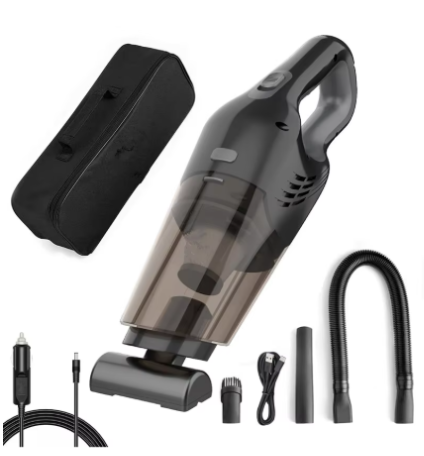உங்கள் வாகனத்திற்கான அவசியமான பராமரிப்பு மற்றும் வீட்டு சுத்தம் செய்யும் நண்பன்
நன்கு பராமரிக்கப்படும் கார் வீடு உங்கள் வாகனம் மற்றும் வாழ்விடங்களை சுத்தமாக வைத்துக்கொள்ள செயற்கை உறிஞ்சி முக்கியமானது. செல்லப்பிராணிகளின் தூசி, உணவுத்துகள்கள் அல்லது அன்றாட தூசி என எதை எதிர்கொண்டாலும், உங்கள் செயற்கை உறிஞ்சியை சரியாக பராமரிப்பதன் மூலம் அதன் சிறப்பான செயல்பாடு மற்றும் நீடித்த தன்மையை உறுதி செய்யலாம். இந்த விரிவான வழிகாட்டி உங்கள் பல்துறை சுத்தம் செய்யும் நண்பனை பராமரிப்பதற்கான அனைத்து தகவல்களையும் வழங்கும்.
சமகால கார் வீட்டு செயற்கை உறிஞ்சிகள் சக்திவாய்ந்த உறிஞ்சும் தன்மையையும், சுமக்கக்கூடிய வசதியையும் கொண்டுள்ளது, இது வாகனம் மற்றும் வீட்டு சுத்தம் செய்யும் பணிகளுக்கு அவசியமானதாக அதனை மாற்றியுள்ளது. இருப்பினும், எந்தவொரு உபகரணத்தைப் போலவே, அவை சிறப்பான செயல்பாட்டைத் தழில்நட்டமாக தொடர தொடர்ந்து பராமரிப்பு தேவைப்படுகிறது. உங்கள் முதலீட்டை அதிகபட்சமாக்கவும், உயர்ந்த தரமான சுத்தம் செய்யும் முடிவுகளை பெறவும் உதவும் செயற்கை உறிஞ்சி பராமரிப்பின் முக்கிய அம்சங்களை பார்க்கலாம்.
பாகங்கள் மற்றும் பராமரிப்பு அடிப்படைகள்
உங்கள் செயற்கை உறிஞ்சியின் கட்டமைப்பை புரிந்து கொள்ளுதல்
ஒவ்வொரு கார் வீட்டு சேறு உறிஞ்சி யந்திரமும் பல முக்கிய பாகங்களைக் கொண்டுள்ளது, இவை சேர்ந்து பயனுள்ள சுத்தம் செய்யும் திறனை வழங்குகின்றன. முதன்மை பாகங்களில் மோட்டார் யூனிட், வடிகட்டி முறைமை, தூசி கொள்கலன் மற்றும் பல்வேறு இணைப்புகள் அடங்கும். உங்கள் சேறு உறிஞ்சி யந்திரத்தின் மொத்த செயல்பாட்டில் ஒவ்வொரு பாகமும் முக்கிய பங்கு வகிக்கின்றது, அவற்றின் பயன்பாடுகளை புரிந்து கொள்வதன் மூலம் உங்கள் பராமரிப்பு பணிகளை சரியான முறையில் செய்ய முடியும்.
மோட்டார் யூனிட் என்பது உங்கள் கார் வீட்டு சேறு உறிஞ்சி யந்திரத்தின் இதயமாக செயல்படுகின்றது, பயனுள்ள சுத்தம் செய்யும் சக்திக்கு தேவையான உறிஞ்சும் திறனை உருவாக்குகின்றது. பொதுவாக பல அடுக்குகளைக் கொண்ட வடிகட்டி முறைமை, மோட்டாரை சென்றடையும் தூசி மற்றும் குப்பைகளை தடுத்து சுத்தமான காற்றை வெளியேற்றுகின்றது. தூசி கொள்கலன் அனைத்து தூக்கிய சேறையும் சேகரிக்கின்றது, மேலும் இணைப்புகள் பல்வேறு பரப்புகள் மற்றும் இடங்களுக்கு பல்துறை சுத்தம் செய்யும் பயன்பாடுகளை வழங்குகின்றது.
தொடர்ந்து ஆய்வு செய்யும் நெறிமுறை
உங்கள் வீட்டு சொம்பு சேகரிப்பானை செயல்திறனுடன் வைத்திருக்க தொடர்ந்து ஆய்வு செய்வது மிகவும் முக்கியமானது. முதலில் வெளிப்புறத்தை பார்த்து எந்த பாதிப்பு அல்லது தளர்ந்த பாகங்கள் இருக்கின்றதா என ஆய்வு செய்யவும். அனைத்து இணைப்புகள் மற்றும் இணைவுகள் சரியாக பொருந்தியுள்ளதா மற்றும் சரியாக செயல்படுகின்றதா என சோதிக்கவும். உங்கள் மாடல் கம்பியுடன் இருந்தால் அல்லது கம்பியில்லாமல் இருந்தால் மின்சார கம்பிகள் அல்லது சார்ஜிங் போர்ட்களை கவனமாக பார்க்கவும்.
தொடர்ந்து ஆய்வு செய்வதன் மூலம் பிரச்சினைகள் மோசமாவதற்கு முன் அவற்றை கண்டறிய முடியும். பிரஷ்களில் உள்ள அழிவு அறிகுறிகளை பார்க்கவும், சக்ஷன் பாதையில் அடைப்பு இருக்கின்றதா என சோதிக்கவும், அனைத்து சீல்களும் பாதுகாப்பாக உள்ளதா என உறுதி செய்யவும். இந்த முனைப்புடன் கூடிய பராமரிப்பு உங்கள் சொம்பு சேகரிப்பானின் ஆயுளை நீட்டிக்கும் மற்றும் அதன் சுத்தம் செய்யும் திறனை பாதுகாக்கும்.
ஃபில்டர் பராமரிப்பு மற்றும் மாற்றம்
வெவ்வேறு வகை ஃபில்டர்களை சுத்தம் செய்தல்
கார் வீட்டு சாய்ப்பு சுத்தம் செய்யும் இயந்திரங்கள் பொதுவாக பல வகையான சுத்திகரிப்பான்களைக் கொண்டுள்ளன, இவை தனிப்பட்ட சுத்தம் செய்யும் முறைகளை தேவைப்படுத்துகின்றன. HEPA சுத்திகரிப்பான்கள் மென்மையான கையாளுதலையும் தொடர்ந்து மாற்றுவதையும் தேவைப்படுத்துகின்றன, மேலும் பாம்பு சுத்திகரிப்பான்களை பொதுவாக கழுவி மீண்டும் பயன்படுத்தலாம். ஒவ்வொரு சுத்திகரிப்பான் வகைக்கும் சரியான சுத்தம் செய்யும் முறையை புரிந்து கொள்வது சிறப்பான செயல்திறனை பராமரிப்பதற்கும், சேதத்தை தடுப்பதற்கும் முக்கியமானது.
கழுவக்கூடிய சுத்திகரிப்பான்களை சுத்தம் செய்யும் போது, குளிர்ந்த நீரை பயன்படுத்தவும், கனமான கழுவும் பொருள்களை பயன்படுத்த வேண்டாம். மீண்டும் பொருத்துவதற்கு முன் சுத்திகரிப்பான்கள் முழுமையாக உலர அனுமதிக்கவும் - பொதுவாக 24 முதல் 48 மணி நேரம் வரை. கழுவ முடியாத சுத்திகரிப்பான்களுக்கு, உற்பத்தியாளர் பரிந்துரைக்கும் அட்டவணைப்படி தொடர்ந்து மாற்றுவது சிறப்பான உறிஞ்சும் தன்மையையும், சுத்திகரிப்பு திறனையும் பராமரிப்பதற்கு அவசியம்.
சிறந்த சுத்திகரிப்பான் மாற்றும் அட்டவணை
உங்கள் கார் வீட்டு சேறுபிடிப்பானின் செயல்திறனை தொடர்ந்து பெறுவதற்கு, ஒரு வடிகட்டி மாற்று அட்டவணையை உருவாக்கி பின்பற்றவும். பெரும்பாலான உற்பத்தியாளர்கள், பயன்பாட்டு அட்டவணை மற்றும் சூழ்நிலைகளை பொறுத்து மூன்று முதல் ஆறு மாதங்களுக்கு ஒரு முறை முதன்மை வடிகட்டிகளை மாற்றுவதை பரிந்துரைக்கின்றனர். HEPA வடிகட்டிகளை ஆறு முதல் பன்னிரண்டு மாதங்களுக்கு ஒரு முறை மாற்ற வேண்டும்.
உங்கள் வடிகட்டி பராமரிப்பு வரலாற்றை கண்காணித்து, எதிர்கால மாற்றங்களுக்கான நினைவூட்டல்களை அமைக்கவும். உங்கள் சிறப்பு மாற்ற அட்டவணையை தீர்மானிக்கும் போது, செல்லப்பிராணிகளை வைத்திருத்தல், ஒவ்வாமை உணர்திறன், மற்றும் சுத்தம் செய்யும் அட்டவணை போன்ற காரணிகளை கருத்தில் கொள்ளுங்கள். உண்மையான மாற்று வடிகட்டிகளை பயன்படுத்துவதன் மூலம் உங்கள் சேறுபிடிப்பானின் உத்தரவாதத்தை பாதுகாத்து கொள்ளலாம், மேலும் சிறந்த செயல்திறனை பெறலாம்.
மின்சார அமைப்பு செயல்திறன் மேம்பாடு
கம்பியில்லா மாடல்களுக்கான பேட்டரி பராமரிப்பு
கேபிள் இல்லாத கார் வீட்டு சொம்பு சுத்தம் செய்யும் இயந்திரங்களுக்கு, நீங்கள் சிறப்பாக செயல்பட வேண்டுமெனில் பேட்டரி பராமரிப்பு மிகவும் முக்கியமானது. சமீபத்திய லித்தியம்-அயன் பேட்டரிகள் முழுமையான சார்ஜ் செய்யும் சுழற்சிகளையும், சரியான சேமிப்பு நிலைமைகளையும் வழக்கமாக பெறுவதன் மூலம் நன்மை பெறுகின்றன. பேட்டரியை மிக அதிகமான வெப்பநிலைக்கு வெளிப்படுத்த வேண்டாம், நீண்ட கால சேமிப்பு காலங்களில் பகுதி சார்ஜை பராமரிக்கவும்.
சார்ஜ் செய்யும் நேரத்தையும், பேட்டரி செயல்திறனையும் கண்காணித்து சாத்தியமான செயலிழப்பை கண்டறியவும். சிறப்பான பராமரிப்பின் கீழ், பெரும்பாலான தரமான பேட்டரிகள் இரண்டு முதல் மூன்று ஆண்டுகள் சிறப்பான செயல்திறனை பராமரிக்க வேண்டும். மாற்றம் அவசியமாகும் போது, பாதுகாப்பு மற்றும் ஒத்துழைப்பை உறுதி செய்ய, எப்போதும் உற்பத்தியாளர் ஒப்புதல் பெற்ற பேட்டரிகளை பயன்படுத்தவும்.
மின்சார கம்பி மற்றும் இணைப்பு பராமரிப்பு
கம்பி கொண்ட கார் வீட்டு சொம்பு சுத்தம் செய்யும் இயந்திர மாதிரிகள் மின்சார கம்பியின் பராமரிப்பிற்கு கவனம் தேவை. கம்பியில் ஏற்பட்ட சேதம், அணிவிப்பு அல்லது வெளிப்படையான வயரிங் ஆகியவற்றை சோதனை செய்து கொண்டே இருக்கவும். கம்பியை சரியான முறையில் சேமிப்பதன் மூலம் குறுக்கம் தடுக்கப்படும், கம்பியின் ஆயுட்காலம் நீடிக்கும் - கம்பியை மிகவும் இறுக்கமாக சுற்றவோ அல்லது சேமிக்கும் போது அதிகப்படியான வலிமையை பயன்படுத்தவோ வேண்டாம்.
மின் இணைப்புகளை சுத்தமாகவும், துகள்கள் இல்லாமலும் வைத்திருக்கவும். அழிப்பு அல்லது பாதிப்புகளுக்கான அறிகுறிகளுக்கு பிளக் பிராங்குகளை சரிபார்க்கவும். மின் சுவரொடு சரியான இணைப்பை உறுதிப்படுத்தவும். பாதுகாப்பு மற்றும் செயல்திறனை பாதுகாக்க எந்தவொரு மின் பிரச்சினைகளையும் உடனடியாக செயல்படுத்தவும்.
சுத்திகரிப்பு செயல்திறன் மேம்பாடு
பிரஷ் ரோல் பராமரிப்பு
உங்கள் கார் வீட்டு சோடிக்கும் வேக்கம் மற்றும் துணி சுத்திகரிப்பிற்கு பிரஷ் ரோல் முக்கியமானது. தொடர்ந்து சுத்தம் செய்வதன் மூலம் சுழற்சியை பாதிக்கக்கூடிய முடிச்சுகள், நூல்கள் மற்றும் துகள்களை நீக்கலாம் மற்றும் சுத்திகரிப்பு செயல்திறனை குறைக்கலாம். சுற்றியுள்ள பொருட்களை கவனமாக நீக்க கத்தி அல்லது உற்பத்தியாளரின் சுத்திகரிப்பு கருவியை பயன்படுத்தவும்.
சுத்திகரிப்பின் போது பிரஷ் ரோல் மணிக்கட்டு மற்றும் இயக்கும் பட்டை நிலைமையை சரிபார்க்கவும். பிரஷ் ரோல் செயல்பாட்டை பாதுகாக்க உரிமை பெற்ற பட்டைகளை உடனடியாக மாற்றவும். சில மாதிரிகளில் பராமரிப்பை எளிதாக்கும் வகையில் பிரஷ் ரோல்களை நீக்க முடியும் - கிடைக்கும் போது இந்த அம்சத்தை பயன்படுத்தவும்.
சக்ஷன் பாதை மேம்பாடு
சிறப்பான சுத்தம் செய்யும் செயல்பாட்டிற்கு தெளிவான உறிஞ்சும் பாதைகளை பராமரித்தல் அவசியம். குழாய்கள், கம்பிகள் மற்றும் இணைப்புகளில் உள்ள அடைப்புகளை சரிபார்த்து அவற்றை நீக்கவும். குறிப்பாக துகள்கள் சேரும் இணைப்பு புள்ளிகளில் கவனம் செலுத்தவும். உற்பத்தியாளர் வழங்கியுள்ள ஏற்ற கருவிகளை பயன்படுத்தி இந்த பகுதிகளை சுத்தம் செய்யவும்.
பயன்பாட்டின் போது உறிஞ்சும் செயல்பாட்டை கண்காணித்து திடீரென சக்தி குறைவு ஏற்பட்டால் உடனே நடவடிக்கை எடுக்கவும். சில சமயங்களில், தூசி பையை காலி செய்து வடிகட்டிகளை சுத்தம் செய்வதன் மூலம் முழுமையான உறிஞ்சும் சக்தியை மீட்டெடுக்கலாம். தொடர்ந்து பிரச்சனை இருப்பின், மறைந்துள்ள தடைகளுக்கு உறிஞ்சும் பாதை முழுவதையும் ஆய்வு செய்யவும்.
அடிக்கடி கேட்கப்படும் கேள்விகள்
எனது கார்/வீட்டு சோடிப்பந்து சுத்தம் செய்யும் கருவியின் வடிகட்டிகளை எவ்வளவு தவணைக்கு ஒருமுறை சுத்தம் செய்ய வேண்டும்?
ிறப்பான செயல்பாட்டிற்கு, கழுவக்கூடிய வடிகட்டிகளை 2-4 வாரங்களுக்கு ஒருமுறை சுத்தம் செய்து, தூய்மைப்படுத்தக்கூடிய வடிகட்டிகளை 3-6 மாதங்களுக்கு ஒருமுறை மாற்றவும். அதிக பயன்பாடு அல்லது செல்லப்பிராணிகள் உள்ள வீடுகள் அடிக்கடி பராமரிப்பு தேவைப்படலாம். பரிந்துரைக்கப்பட்ட சுத்தம் செய்யும் இடைவெளிகளுக்கு உங்கள் குறிப்பிட்ட மாதிரி கைப்புத்தகத்தை எப்போதும் சரிபார்க்கவும்.
னது சோடிப்பந்து சுத்தம் செய்யும் கருவிக்கு தொழில்முறை சேவை தேவைப்படுகிறது என்பதை குறிக்கும் அறிகுறிகள் எவை?
சக்ஷன் இழப்பு, விசித்திரமான ஒலிகள், எரிமான வாசனை, அல்லது அடிப்படை பராமரிப்பு செய்தாலும் தீராத மெக்கானிக்கல் பிரச்சினைகள் ஆகியவற்றை நீங்கள் கண்டறிந்தால், தொழில்முறை சேவையைக் கருத்தில் கொள்ளவும். மேலும், உங்கள் கார் வீட்டு வேக்குவம் இன்னும் உத்தரவாதத்தின் கீழ் இருந்தால், உத்தரவாதத்தை பராமரிக்க தொழில்முறை சேவை தேவைப்படலாம்.
என் வேக்குவின் பேட்டரியின் ஆயுளை எவ்வாறு அதிகப்படுத்தலாம்?
பேட்டரியின் ஆயுளை நீட்டிக்க, மீண்டும் சார்ஜ் செய்வதற்கு முன் பேட்டரியை முழுமையாக காலி செய்வதைத் தவிர்க்கவும், வேக்குவை அறை வெப்பநிலையில் சேமிக்கவும், மற்றும் உற்பத்தியாளர் அங்கீகரித்த சார்ஜிங் உபகரணங்களை மட்டும் பயன்படுத்தவும். நீண்ட காலம் சேமிப்பதை விட தொடர்ந்து பயன்படுத்துவது பேட்டரிக்கு நல்லது. மிகவும் வெப்பமான அல்லது குளிர்ந்த சூழ்நிலைகளில் சார்ஜ் செய்வதைத் தவிர்க்கவும்.

